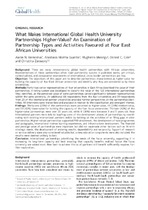| dc.contributor.author | Yarmoshuk, Aaron N. | |
| dc.contributor.author | Guantai, Anastasia Nkatha | |
| dc.contributor.author | Mwangu, Mughwira | |
| dc.contributor.author | Cole, Donald C. | |
| dc.contributor.author | Zarowsky, Christina | |
| dc.date.accessioned | 2018-10-15T13:56:29Z | |
| dc.date.available | 2018-10-15T13:56:29Z | |
| dc.date.issued | 2018 | |
| dc.identifier.citation | Yarmoshuk A, et al. (2018). What makes international global health university partnerships higher-value? An examination of partnership types and activities favoured at four East African universities. Annals of Global Health, 84(1): 139–150. | en_US |
| dc.identifier.issn | 2214-9996 | |
| dc.identifier.uri | https://doi.org/10.29024/aogh.20 | |
| dc.identifier.uri | http://hdl.handle.net/10566/4126 | |
| dc.description.abstract | BACKGROUND: There are many interuniversity global health partnerships with African universities. Representatives of these partnerships often claim partnership success in published works, yet critical, contextualized, and comparative assessments of international, cross-border partnerships are few.
OBJECTIVE: The objectives of this paper are to describe partnerships characterized as higher-value for building the capacity of four East African universities and identify why they are considered so by these universities.
METHODS: Forty-two senior representatives of four universities in East Africa described the value of their partnerships. A rating system was developed to classify the value of the 125 international partnerships they identified, as the perceived value of some partnerships varied significantly between representatives within the same university. An additional 88 respondents from the four universities and 59 respondents from 25 of the international partner universities provided further perspectives on the partnerships identified. All interviews were transcribed and analysed in relation to the classification and emergent themes.
FINDINGS: Thirty-one (25%) of the partnerships were perceived as higher-value, 41 (33%) medium-value, and 53 (42%) lower-value for building the capacity of the four focus universities. Thirteen (42%) of the higher-value partnerships were over 20 years old, while 8 (26%) were between 3 and 5 years old. New international partners were able to leapfrog some of the development phases of partnerships by coordinating with existing international partners and/or by building on the activities of or filling gaps in older partnerships. Higher-valued partnerships supported PhD obtainment, the development of new programmes and pedagogies, international trainee learning experiences, and infrastructure development. The financial and prestige value of partnerships were important but did not supersede other factors such as fit with strategic needs, the development of enduring results, dependability and reciprocity. Support of research or service delivery were also considered valuable but, unless education components were also included, the results were deemed unlikely to last.
CONCLUSION: International partnerships prioritizing the needs of the focus university, supporting it in increasing its long-term capacity and best ensuring that capacity benefits realized favour the focus university are valued most. How best to achieve this so all partners still benefit sufficiently requires further exploration. | en_US |
| dc.language.iso | en | en_US |
| dc.publisher | Levy Library Press | en_US |
| dc.rights | © 2018 The Author(s). This is an open-access article distributed under the terms of the Creative Commons
Attribution 4.0 International License (CC-BY 4.0), which permits unrestricted use, distribution, and reproduction in any medium,
provided the original author and source are credited. See http://creativecommons.org/licenses/by/4.0/. | |
| dc.subject | Interuniversity global health partnerships | en_US |
| dc.subject | African universities | en_US |
| dc.subject | Partnerships | en_US |
| dc.title | What makes international global health university partnerships higher-value? An examination of partnership types and activities favoured at four East African universities | en_US |
| dc.type | Article | en_US |
| dc.privacy.showsubmitter | FALSE | |
| dc.status.ispeerreviewed | TRUE | |
| dc.description.accreditation | ISI | |

